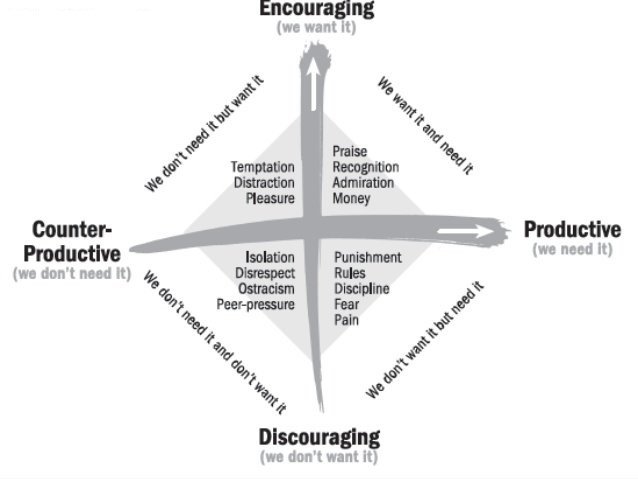Part 4: Identifying Our Triggers
No matter how extreme the circumstances, when it comes to our behavior, we always have a choice

We start with Feedback - both the act of giving it and taking it, is our first step in becoming smarter, more mindful about the connection between our environment and our behavior. Feedback teaches us to see our environment as a triggering mechanism. In some cases, the feedback itself is the trigger
A Feedback loop comprises four stages:
- Evidence
- Relevance
- Consequences
- Action
For example:
- Drivers get data about their speed in real time
- The information indicates whether they're obeying the rule or breaking the law
- Aware that they're speeding, drivers fear getting a ticket or hurting someone
- So they slow down
This is how feedback ultimately triggers desirable behavior. Once we deconstruct feedback into its four stages, the world never looks the same again. Suddenly, we understand that our good behavior is not random. It's logical, it follows a pattern, it makes sense, it's within our control, it's something we can repeat.
It's why some obese people finally and instantly take charge of their eating habits when they're told that they have diabetes and will die or go blind if they don't make a serious lifestyle change.
What if we could control our environment so it triggered our most desired behavior - like an elegantly designed feedback loop? instead of blocking us from our goals.
To achieve that, we first have to clarify the term Trigger: A behavioral trigger is any stimulus that impacts our behavior
Behavioral triggers can be:
- Direct or Indirect
- Internal or External
- Conscious or Unconscious
- Anticipated or Unexpected
- Encouraging or Discouraging
- Productive or Counterproductive
Triggers are not inherently "good" or "bad" What matters is our response to them
Most of us want short-term gratification while we need long-term benefit. And we never get a break from choosing one or the other. It's the defining conflict of adult behavioral change, and we write the definitions. We define what makes a trigger encouraging, we define what makes a trigger productive. If only our encouraging triggers and productive triggers were the same, it can happen, it's the ideal situation. Unfortunately, what we want often lures us away from what we need.

We Want It and Need It: The upper right quadrant is where we'd prefer to be all the time. they make us try harder right now and they also reinforce continuing behavior that drives us towards our goal. We want them now and need them later
We Want It but Don't Need It: You know how an appealing distraction can trigger a self-defeating choice, you've sacrificed your goals for short-term gratification, and you also know how positive reinforcement can set you back rather than propel you ahead.
We Need It but Don't Want It: Rules (or any highly structured environment) are discouraging because they limit us; they exist to erase specific behaviors from our repertoire. But we need them because obeying rules makes us do the right thing. Fear - of shame, punishment, regret, disrespect is a hugely discouraging trigger, which makes it a powerful motivator to stay true to your long-term goals. Pain is the ultimate discouraging trigger.
We Don't Need it or Want It: This quadrant includes all the dead-end situation that makes us miserable - and we can't see any way out of them. It could be a toxic workplace, violent neighborhood, the kinds of environment that triggers unhealthy behavior steering us away from our goals. there's not much mystery why these ugly environment triggers fatigue, stress, and hopelessness. The only puzzle is why we choose to stay here instead of fleeting at high speed.
I find this grid useful as an analytical tool to take the inventory of the triggers in our lives, which, if nothing else, increases the awareness of our environment. More importantly, it reveals whether they're operating in a productive quadrant. The right side of the matrix where all of us want to be, moving forward on our behavioral goals.
A simple useful exercise:
- Pick a behavioral goal you're still pursuing
- List the people and situations that influence the quality of your performance
- Chart the triggers to see if you're on the right side
You might learn that you regularly miss your early morning workout because you waste your wake up hours on social media or checking emails. You need the former, want the latter. It doesn't solve the puzzle of achieving behavioral change, but it's a start in the right direction.